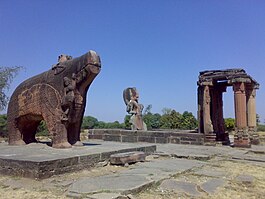Draft:Battle of Eran
 | Review waiting, please be patient.
This may take 3 months or more, since drafts are reviewed in no specific order. There are 2,574 pending submissions waiting for review.
Where to get help
How to improve a draft
You can also browse Wikipedia:Featured articles and Wikipedia:Good articles to find examples of Wikipedia's best writing on topics similar to your proposed article. Improving your odds of a speedy review To improve your odds of a faster review, tag your draft with relevant WikiProject tags using the button below. This will let reviewers know a new draft has been submitted in their area of interest. For instance, if you wrote about a female astronomer, you would want to add the Biography, Astronomy, and Women scientists tags. Editor resources
Reviewer tools
|
The Battle of Eran (510)[1] or First Battle of Eran[2]was a conflict between Bhanugupta, a provincial Gupta Chief, and the Hūņas or Alchon Huns, led by Toramana and his son Mihirakula. The battle occurred in the Eran region in A.D. 510, resulting in significant consequences for the Gupta Empire's control over Malwa.
[1]
| Battle of Eran | |||||||||
|---|---|---|---|---|---|---|---|---|---|
 The Eran boar inscription | |||||||||
| |||||||||
| Belligerents | |||||||||
| Gupta Empire |
| ||||||||
| Commanders and leaders | |||||||||
|
Bhanugupta Goparaja † |
| ||||||||
| Strength | |||||||||
| Unknown | Unknown | ||||||||
| Casualties and losses | |||||||||
| Heavy | Less | ||||||||
Background[edit]
Bhanugupta, identified as possibly the Governor of Malwa under the Gupta Empire, faced increasing pressure from the Hūņas, a Central Asian nomadic tribe led by Toramana. The Hūņas sought to expand their influence westward, leading to clashes with Gupta forces in the region.[3][4]
Battle[edit]


 "Tora" in Brahmi script appear in large letters on the reverse, under the solar wheel design.[5][6]
"Tora" in Brahmi script appear in large letters on the reverse, under the solar wheel design.[5][6]The Battle of Eran in 510 A.D. saw Bhanugupta and his military lieutenant, Goparāja, confront Toramana's Hūņa forces. Despite Goparāja's renowned prowess, he fell fighting in the battle, allowing the Hūņas to advance further towards Magadha.[1] This marked a significant loss for Bhanu Gupta and the Gupta Empire in their defense against the Alchon Huns or Huna incursions.[7][8]
Aftermath[edit]

Following the battle, Toramana asserted his supremacy in Malwa, indicating the Gupta Empire's loss of control over the region. The defeat of Bhanugupta and the advance of the Huns towards Magadha signaled a period of turmoil for the Gupta Empire. The subsequent rule of Toramāna and his son Mihirakula further solidified Hūņa influence in the region, impacting the political landscape of ancient Subcontinent.[3]
Refrences[edit]
- ^ a b c Radhakumud Mookerji (1997). The Gupta Empire (5th ed.). Delhi: Motilal Banarsidass. p. 120. ISBN 978-81-208-0440-1.
- ^ Balogh, Dániel (2020-03-12). Hunnic Peoples in Central and South Asia: Sources for their Origin and History. Barkhuis. p. 339. ISBN 978-94-93194-01-4.
- ^ a b Agrawal, Ashvini (1989). Rise and Fall of the Imperial Guptas. Motilal Banarsidass Publ. ISBN 978-81-208-0592-7.
- ^ Fisher, William Bayne; Yarshater, Ehsan (1968). The Cambridge History of Iran. Cambridge University Press. p. 214. ISBN 978-0-521-20092-9.
- ^ Alram, Michael (2003). "Three Hunnic Bullae from Northwest India" (PDF). Bulletin of the Asia Institute. 17: 180, Figure 11. ISSN 0890-4464. JSTOR 24049314.
- ^ Dani, Ahmad Hasan; Litvinsky, B. A. (1996). History of Civilizations of Central Asia: The crossroads of civilizations, A.D. 250 to 750. UNESCO. p. 175. ISBN 9789231032110.
- ^ Ojha, N.K. (2001). The Aulikaras of Central India: History and Inscriptions, Chandigarh: Arun Publishing House, ISBN 81-85212-78-3, pp.409-410
- ^ Majumdar, R. C. (2016-01-01). Ancient India. Motilal Banarsidass. p. 241. ISBN 978-81-208-0435-7.
